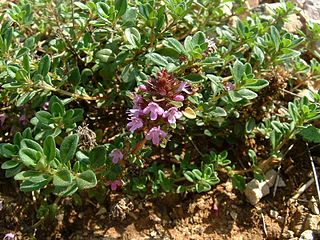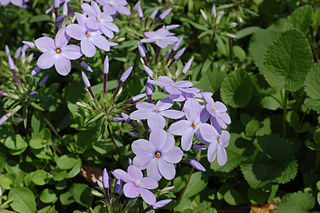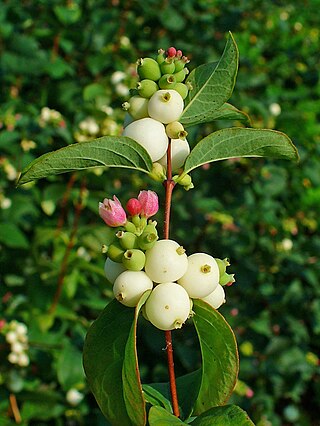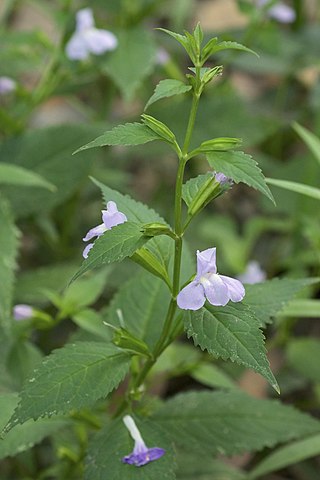
Butomus umbellatus is a Eurasian plant species in the family Butomaceae. It is the only species in the family. Common names include flowering rush or grass rush. Introduced into North America as an ornamental plant it has now become a serious invasive weed in the Great Lakes area and in parts of the Pacific Northwest. In Israel, one of its native countries, it is an endangered species due to the habitat loss. It can also be found in Great Britain locally, for example at the Caldicot and Wentloog Levels The plant is a rhizomatous, hairless, perennial aquatic plant. Its name is derived from Greek bous, meaning "cow", "ox" etc. and tome, a cut, which refers to the plant's swordlike leaves.

Leucanthemum vulgare, commonly known as the ox-eye daisy, oxeye daisy, dog daisy, marguerite and other common names, is a widespread flowering plant native to Europe and the temperate regions of Asia, and an introduced plant to North America, Australia and New Zealand.

Nelumbo lutea is a species of flowering plant in the family Nelumbonaceae. Common names include American lotus, yellow lotus, water-chinquapin, and volée. It is native to North America. The botanical name Nelumbo lutea Willd. is the currently recognized name for this species, which has been classified under the former names Nelumbium luteum and Nelumbo pentapetala, among others.

Thymus serpyllum, known by the common names of Breckland thyme, Breckland wild thyme, wild thyme, creeping thyme, or elfin thyme, is a species of flowering plant in the mint family Lamiaceae, native to most of Europe and North Africa. It is a low, usually prostrate subshrub growing to 2 cm (1 in) tall with creeping stems up to 10 cm (4 in) long. The oval evergreen leaves are 3–8 mm long. The strongly scented flowers are either lilac, pink-purple, magenta, or a rare white, all 4–6 mm long and produced in clusters. The hardy plant tolerates some pedestrian traffic and produces odors ranging from heavily herbal to lightly lemon, depending on the variety.

Phlox stolonifera is a species of flowering plant in the family Polemoniaceae. It is a perennial herbaceous plant that is native to the eastern United States. It occurs in woodlands and stream banks in the vicinity of the Appalachian Mountains from Pennsylvania south to northern Georgia. Naturalized populations occur as far north as Québec, Canada.

Iris pseudacorus, the yellow flag, yellow iris, or water flag, is a species of flowering plant in the family Iridaceae. It is native to Europe, western Asia and northwest Africa. Its specific epithet pseudacorus means "false acorus", referring to the similarity of its leaves to those of Acorus calamus, as they have a prominently veined mid-rib and sword-like shape. However, the two plants are not closely related. The flower is commonly attributed with the fleur-de-lis.

Spiranthes spiralis, commonly known as autumn lady's-tresses, is an orchid that grows in Europe and adjacent North Africa and Asia. It is a small grey-green plant. It forms a rosette of four to five pointed, sessile, ovate leaves about 3 cm (1.2 in) in length. In late summer an unbranched stem of about 10–15 cm (3.9–5.9 in) tall is produced with approximately four sheath-shaped leaves. The white flowers are about 5 mm (0.20 in) long and have a green spot on the lower lip. They are arranged in a helix around the upper half of the stalk. The species is listed in Appendix II of CITES as a species that is not currently threatened with extinction but that may become so. Autumn lady's-tresses are legally protected in Belgium and the Netherlands.

Iris giganticaerulea, the giant blue iris, is a species of iris, in the subgenus Limniris, in the series Hexagonae. It is a rhizomatous perennial, from northern America. It has long bright green leaves, very tall stems and one or two musky fragrant flowers in a range of blue shades or rarely white.

Iris cristata is a species in the genus Iris, it is also in the subgenus of Limniris. It is a rhizomatous perennial plant, endemic to the eastern United States. It has pale lavender flowers with a white patch and orange or yellow crest. It is a close relative to Iris lacustris, the only other crested iris native to North America. It is cultivated as an ornamental plant in temperate regions.

Bolbitis heudelotii, also known as the African water fern, creeping fern, and Congo fern, is native to subtropical and tropical Africa, from Ethiopia west to Senegal; and down to northern South Africa.

Goodyera pubescens, the downy rattlesnake plantain, is one of the most common orchids native to eastern North America. It is found from Florida to Nova Scotia, west to eastern Oklahoma, Minnesota and Ontario.

Ludwigia peploides is a species of flowering plant in the evening primrose family known by the common names floating primrose-willow and creeping water primrose. It is native to Australia, New Zealand, North America, and South America, but it can be found on many continents and spreads easily to become naturalized. It is well known as a troublesome aquatic noxious weed that invades water ecosystems and can clog waterways. This is perennial herb which grows in moist to wet to flooded areas. The stem can creep over 2 meters long, sometimes branching. It spreads to form mats on the mud, or floats ascending in the water. The leaves are several centimeters long and are borne in alternately arranged clusters along the stem. The flower has 5 to 6 lance-shaped sepals beneath a corolla of 5 or 6 bright yellow petals up to 2.4 centimeters long. The fruit is a hard, cylindrical capsule.

Symphoricarpos albus is a species of flowering plant in the honeysuckle family known by the common name common snowberry. Native to North America, it is browsed by some animals and planted for ornamental and ecological purposes, but is poisonous to humans.
Justicia cooleyi is a rare species of flowering plant in the family Acanthaceae known by the common name Cooley's water-willow. It is endemic to Florida in the United States, where it occurs in three counties. It is a federally listed endangered species.

Mimulus alatus, the sharpwing monkeyflower, is an herbaceous eudicot perennial that has no floral scent. It is native to North America and its blooming season is from June to September. The flowering plant has green foliage and blue to violet flowers. It has a short life span compared to most other plants and a rapid growth rate. Like other monkey-flowers of the genus Mimulus, M. alatus grows best in wet to moist conditions and has a bilabiate corolla, meaning it is two-lipped. The arrangement of the upper and lower lip petals suggests a monkey’s face. The winged stems together with the monkey face give the plant its common name.

Iris grant-duffii is a species in the genus Iris. It is also in the subgenus Limniris and in the series Syriacae. It is a rhizomatous perennial, from Lebanon, Israel, Syria, Turkey, Lebanon and Iraq, which has brown bristles/spines on the rhizome, long thin greyish green leaves, short stem carrying a single scented flower in shades of yellow.

Iris vorobievii is a plant species in the genus Iris, it is also in the subgenus of Iris and in the Psammiris section. It is a rhizomatous perennial, from Russia close to the Chinese border. It has long and thin green leaves, similar sized stem and pale yellow or bright yellow flowers with a pale yellow beard. It is cultivated as an ornamental plant in temperate regions.

Iris scariosa is a plant species in the genus Iris, it is also in the subgenus Iris. It is a rhizomatous perennial, from the mountainsides of Russia, Kazakhstan, Mongolia and China. It has sword-like, or sickle shaped, blue green or grey-green leaves, a short flowering stem, 3 or 4 membranous or semi-transparent flower bud leaves, 2 violet, reddish violet, lilac, blue-purple, or blue flowers in late spring, with yellow or white beards. It is cultivated as an ornamental plant in temperate regions. It was merged with another similar iris in the region, and Iris glaucescens became a synonym of Iris scariosa, before being divided into two separate species again. Although some sources still call it the main species, despite a slight colour difference.

Teucrium canadense, commonly known as Canada germander, American germander, or wood sage, is a perennial herb in the family Lamiaceae. It is native to North America where it is found across the contiguous states of the United States and in much of Canada.

Veronica catenata, the pink water speedwell, is a species of flowering plant in the family Plantaginaceae. It is native to Canada, the United States, Europe, the Azores, and northern Africa. As its common name implies, it prefers growing in or near marshes, rivers, lakes and ponds.





















